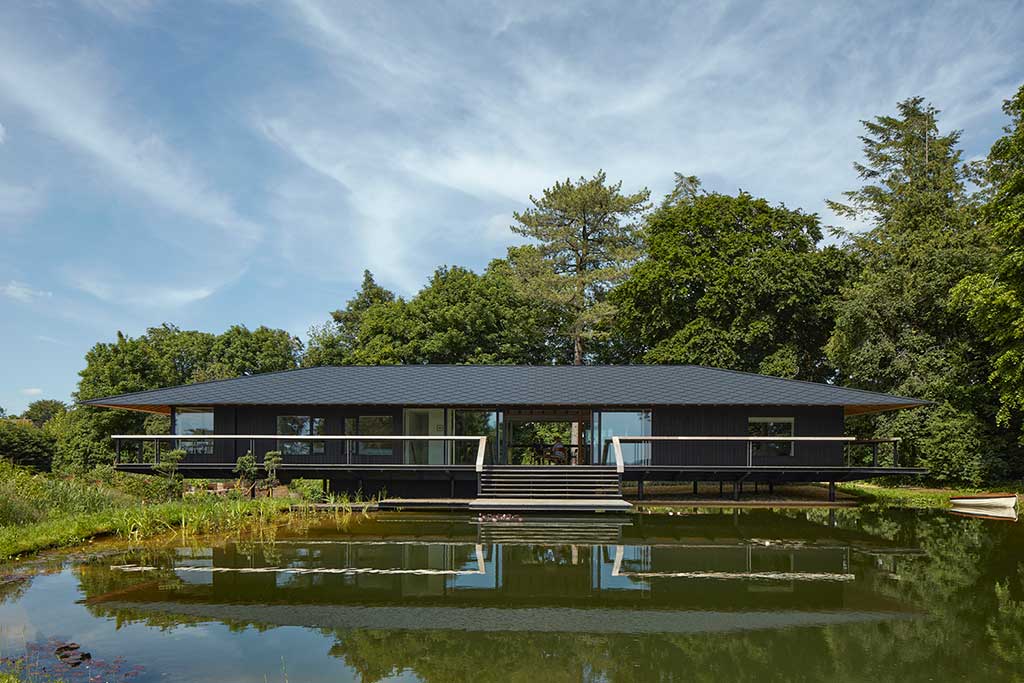Sustainability and connections with nature are driving innovative and exciting architecture across the UK. However, these concepts are central to traditional Japanese architecture. It is, therefore, no wonder that contemporary designers seek inspiration from historic, oriental buildings. A wonderful example is Blackbird.
A Charred Timber Clad Building Poised over a Lake
Blackbird is a stunning home, which is reflected in the manmade lake that it appears to hover over. Designed by Hamish & Lyons, it is distinct from the neighbouring Cotswold stone properties of Cirencester.
The vision for the building is a blackbird in flight, skimming the water’s surface with wings outstretched.
Finished in charred timber cladding, a traditional Japanese building material, this low-profile property merges into the surrounding landscape. The covered veranda and sliding doors also work to blend the internal and external spaces. This creates a space that isn’t fixed but flows and adapts to best fit the requirements of the occupants.
Sustainability is at the heart of this build. It follows Passivhaus principles, with high levels of air tightness and renewable energy sources. The new lake discretely houses a water source heat pump, whilst reflection off the surface optimises natural light. All materials are responsibly sourced and the building is constructed in a way that enables them to be dismantled for recycling at the end of the building’s life.
We were delighted that Shou Sugi Ban® charred timber cladding was specified as one of the premium building materials used to create this elegant home. We supplied dark, textured Kebony Radiata Pine, Minami–no timbers which are traditional in style, yet fully compliant with modern building requirements.

Features of Japanese Architecture
Blackbird is far from a replica of traditional Japanese Architecture, yet it draws inspiration from some of its key features. The use of wood, the profile of the roof and the transition between interior and exterior spaces.
Sustainable Timber Buildings
In Japan, timber is a practical and durable material; it is widely available and suited to both the changing seasons and earthquake risk. If necessary, it is far easier to rebuild than stone, brick or concrete structures. This is enhanced by the fact that notches and slots in the wood allowed buildings to be constructed without the use of nails.
As a natural material, wood is revered in Japan, so it is seldom painted. Yakisugi charring is used as a timber preservation method, but coating the wood and covering up the natural grain and texture is regarded as disrespectful. The lack of additional applications also makes it easier to reuse or recycle.
An Elongated Roof & Engawa
Japanese buildings typically feature gabled, hipped or Pyramidical roof styles. The extended eaves protect the windows from rain and create a cover over the Engawa. They also seem to ground the building into its plot.
An engawa is an open verandah, following the circumference of the building. It is part of the house that helps to connect inside and out; a principle that is now widely referred to as biophilic. The Engawa provides a space to enjoy the fresh air and uninterrupted views of nature whatever the weather. It is sheltered from the rain and offers shade from the sun.

Stunning Architectural Design
We admire the way these features have been incorporated into the design of a contemporary, British home, in a way that makes it feel as though the property has always been there. It is ingrained in its setting.
Hamish & Lyon achieved award-winning success with their first project, Stepping Stones. We can imagine that the simplified, yet aspirational form of Blackbird will also receive much acclaim.
If you are planning a stylish build that would be perfectly suited to a finish in Shou Sugi Ban® charred timbers, please get in touch on 01494 711800. We offer a range of finishes, from black and textured, to smooth, lighter tones and are happy to send samples with a quote.
Photography by ©James Brittain
Architect: _and-lyons-architects with Hamish Herford www.andlyons.com
